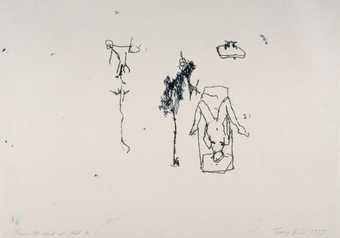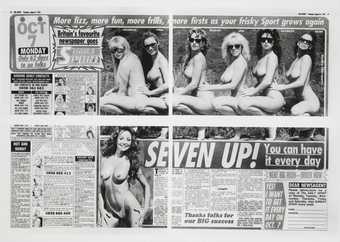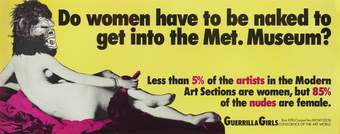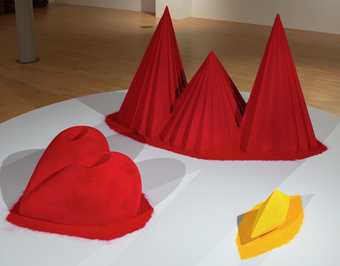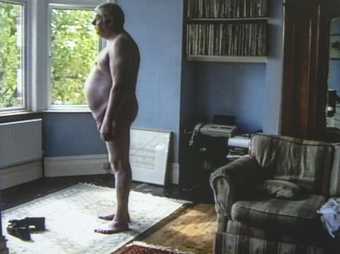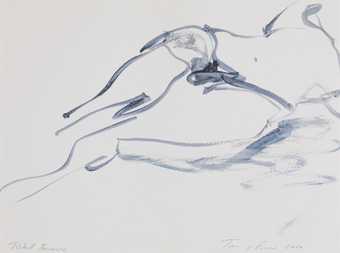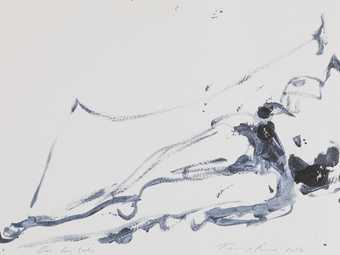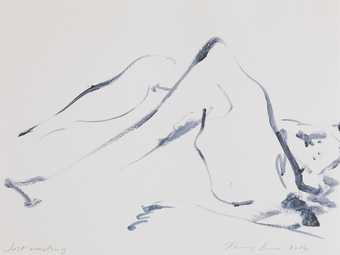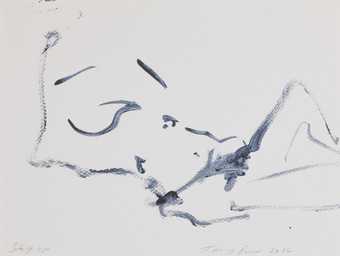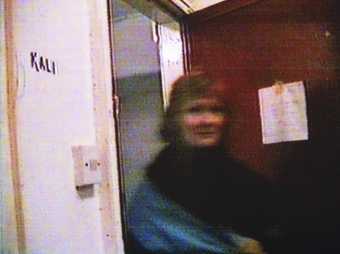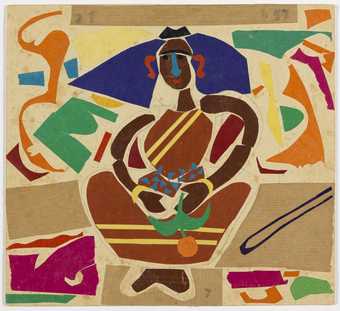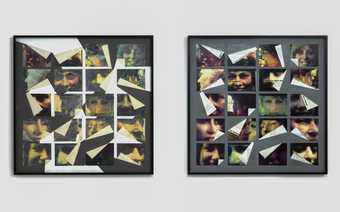In Tate Britain
- Artist
- Sutapa Biswas born 1962
- Medium
- Graphite on paper
- Dimensions
- Displayed: 1856 × 2486 × 44 mm
frame, each: 612 × 822 × 44 mm - Collection
- Tate
- Acquisition
- Purchased 2018
- Reference
- T15041
Summary
To Touch Stone 1989–90 is a large-scale drawing by Sutapa Biswas of a reclining naked woman (the artist’s sister) occupying nine sheets of paper arranged in a three-by-three grid. The image of the figure is both formed and unformed, with elements of the body existing only in outline (arms, legs, hair and breasts) with the face and genital area being most fully realised. The figure lies flat, diagonally stretched across the work with the feet at the bottom left corner and the head in the top right. Two sheets are completely blank (top left and middle left), while the ground on which the figure rests is delineated not by line but by a flowing ribbon of words that occupy the lower middle right sheets and the middle right sheets. These words read:
from somewhere . from somewhere an indistinct sound came . murmer ~ n . to mutter; a rustling from the heart, lungs, etc., to touch stone . to touch stone . sometimes . stream ~ n , a running water; a river [, to touch stone .] or brook or rivulet ; a current ; to flow or issue in a stream, to run with liquid . on Saturday etc. etc to touch stone to touch stone . to touch stone . sometimes to touch stone with . liquid . weigh indistinct sounds . to murmer . to mutter . heart, lungs etc., a rustling sound from the heart . streams ~ n . to run with liquid, to touch stone . to touch stone . to touch stone . sound ~ v.t.i , to measure the depth of . from somewhere an indistinct sound , sounds ~ n . to touch stone stream ~ n , a running water ; a river , brook or rivulet , a current . to weigh in indistinct sounds like water . to touch stone to touch stone . to touch stone . to touch stone . sometimes . like water . to weigh indistinct sounds . a brook . or rivulet . murmer ~ n . to mutter . murmer.
An idea of emergence from fragmentation and absence is emphasised by the blank sheets of paper that make up the work as well as by the shift in technique to picturing the figure. Biswas’s engagement with issues of identity was largely played out at this time through a representation of metaphors for becoming (primarily read through the writing of the philosopher Gilles Deleuze). This idea of becoming is figured through her conjunction of image and text communicating a passage of time and a coalescing of being and identity. Furthermore, the image of a prone naked figure is situated within text that defines paradoxes of existence – sound that is weighed or stone being a hard substance that changes over geological time – subject to the transitory touch of running water, fingers or the rhythm of heart and breath.
The art historian Griselda Pollock has identified To Touch Stone as an example of Biswas’s underlying strategy to ‘“demythologise” otherness’, or to resist and undermine the sense of separation and alienation common to the postcolonial world:
The myth produced by imperialism/Orientalism is that there are other lands, rather than the spaces of interaction. To contest that myth is to refuse to be constructed as ‘belonging elsewhere’. For Asian artists born in India and growing up in Britain, for those intellectuals who actively see themselves living across the mythic spaces of a postcolonial world ... refusing in their persons to confirm that division, the critical project is the articulation of this demythologised, de-alienated space.
(Griselda Pollock, ‘Tracing Figures of Presence: Naming Ciphers of Absence, Feminism, Imperialism and Postmodernity: The Work of Sutapa Biswas’, in Institute of International Visual Arts 2004, pp.30–2.)
The portrayal by Biswas of a reclining naked Asian woman continues her interest in the history of such subjects and stems in part from her engagement with Edouard Manet’s painting Olympia 1863 as a student at Leeds University between 1981 and 1984. The famous painting depicts a naked white sex worker reclining on a bed being offered flowers by a Black attendant. As an artist Biswas was interested in the marginalisation of the Black figure in art historical commentaries of the painting where, in Biswas’s words, ‘visibility is everything’, and therefore ‘unpicking histories of invisibility is necessary’ (email correspondence with Tate curator Andrew Wilson, 21 September 2017).
It is as much the image of the reclining central figure of Olympia as the absences within readings of the painting that provide starting points for To Touch Stone. In Biswas’s work, the angle of the reclining figure shifts to become a prone figure; perspective and gaze alter as does the racial identity of the figure. For Biswas, To Touch Stone
visually echoes a shared, yet differently violated space. Simultaneously, it represents (a) the desire to resist erosion/corrosion (sustain visibility / presence) and (b) the desire being taken out of the race/gender/class binaries (washed away to nothing by dust). The burden of representation or voice is a tough space in itself to occupy. In India in Varnasi, the ashes of a funeral pyre are put into the flow of the Ganges. To Touch Stone occupies a place of trauma, between life and death. I wish life but am met by death. Perhaps it is only in the putting together of fragments of paper that we can but recover a sense of ‘being’ and a resistance to our erasure across time and space.
(Email correspondence with Tate curator Andrew Wilson, 1 May 2019.)
To Touch Stone was first shown in the group exhibition The Circular Dance at the Arnolfini in Bristol in 1991, which also included work by Chila Kumari Burman, Jagjit Chuhan, Nina Edge, Gurminder Sikand and Shanti Thomas. There it was exhibited alongside a group of pastel and pencil drawings by Biswas entitled Sacred Spaces 1990 (see Arnolfini 1991, p.23). These consisted of drawings of Biswas’s sister’s head and shoulders, where the facial features may have been drawn-in in pastel leaving the area of hair, neck and shoulders in outline. These works, alongside To Touch Stone, suggest the fluidity or formation of identity, both through the use of her similar-looking sister as model, but also through the contrast between blankness and fully described form.
To Touch Stone makes reference to a range of earlier art forms, including erotic Indian temple sculpture such as that found at Ajanta and Ellora, and American artist Robert Rauchenberg’s series of White Paintings from 1951, which Biswas had discovered as an art student in the early 1980s. For Biswas, the blankness of the White Paintings provided a space of incident in which presence could be traced. The blank sheets in To Touch Stone offer a counterpoint to the fully described passages, but more directly Biswas evolved ‘the idea of a white space as a metaphor for “institutional spaces”. By incorporating physical large white spaces within my works, wherein meaning could evolve to disrupt that which was already defined within it ... I was re-inscribing that “white space”’ (email correspondence with Tate curator Andrew Wilson, 21 September 2017).
Further reading
The Circular Dance, exhibition catalogue, Arnolfini, Bristol 1991.
Transforming the Crown: African, Asian & Caribbean Artists in Britain, 1966−1996, exhibition catalogue, Caribbean Cultural Center / African Diaspora Institute, New York 1997.
Sutapa Biswas, exhibition catalogue, Institute of International Visual Arts, London 2004, reproduced p.31.
Andrew Wilson
November 2017, revised May 2019
Does this text contain inaccurate information or language that you feel we should improve or change? We would like to hear from you.
Explore
- abstraction(8,615)
-
- non-representational(6,161)
-
- text(1,043)
- formal qualities(12,454)
-
- fragmentation(233)
- actions: postures and motions(9,111)
-
- lying down(392)
- woman(9,110)
- Asian(117)
- female(1,681)
- birth to death(1,472)
-
- mortality(49)
- gender(1,689)
- marginalisation(192)
- race(381)
You might like
-
Tracey Emin From the Week of Hell ‘94
1995 -
Sarah Lucas Seven Up
1991 -
Guerrilla Girls Do Women Have To Be Naked To Get Into the Met. Museum?
1989 -
Sir Anish Kapoor CBE RA As if to Celebrate, I Discovered a Mountain Blooming with Red Flowers
1981 -
Raqib Shaw Jane
2006 -
Linder Untitled
1976 -
Sutapa Biswas Untitled (The Trials and Tribulations of Mickey Baker)
1997, re–edited and re–mastered 2002 -
Tracey Emin Total Reverse
2014 -
Tracey Emin On her Side
2014 -
Tracey Emin Just Waiting
2014 -
Tracey Emin Stay Up
2014 -
Sutapa Biswas Kali
1983–1985 -
Benode Behari Mukherjee Lady with Fruit
1957 -
Marie Yates Image/woman/text
1979


